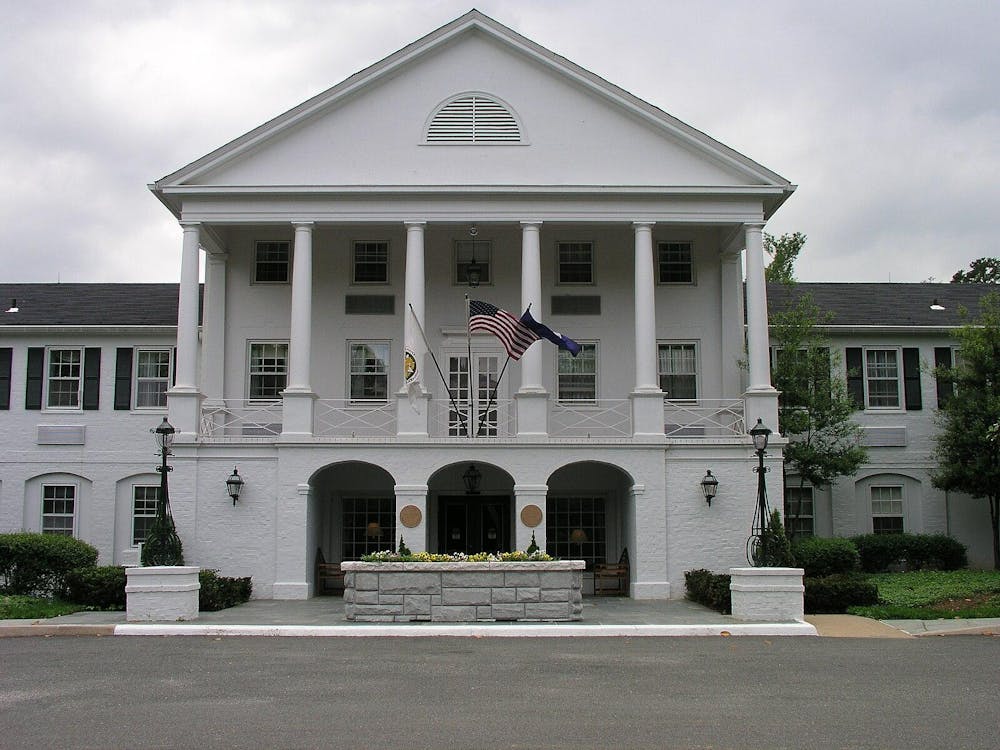The confrontation between the Living Wage Campaign and University officials reached the boiling point recently as student activists initiated a hunger strike and began protesting across the street from the office of University President Teresa Sullivan. The standoff is the latest in a long history of negotiations between University administrators and advocates for a living wage.
A history of activism
In April 2006, 17 student members of the campaign marched to the office of University President John Casteen III and staged a sit-in demanding an audience with Casteen. The four-day-long protest prompted Casteen to order the arrests of the students involved. The students were later released after a recording proved their protest to be nonviolent.
History Prof. Paul Gaston gave a keynote speech at the beginning of the 2006 campaign, discussing its aims.
“[The campaign is about] whether all members of the university community are respected for their contribution to fulfilling the University’s educational mission, or whether poverty and inequality will continue to exist side-by-side with lessons in ethics and citizenship,” said Gaston, a civil rights activist and scholar, in a Feb. 21, 2006 speech delivered on the Rotunda steps.
At a campaign rally Friday, Gaston recounted the 1969 University protest he felt marked the movement’s beginning. Students rallied at the Rotunda advocating higher salaries for University employees, as well as the admission of women into the University.
“This Living Wage movement is endowed with every bit as much moral clarity as that which infused the 1960s civil rights movement,” Gaston said.
Following Sullivan’s arrival in fall 2010, activists for a living wage restarted their campaign, organizing teach-ins, rallies and peaceful protests, rallying outside Board meetings and gaining the support of City Council members and former Charlottesville Mayor Dave Norris.
The campaign called for a day of action April 20, 2011, which resulted in the University raising salaries in November 2011.
The demands of the campaign
The campaign now calls for the University to implement a $13 per hour living wage indexed to yearly inflation as provided for by the calculations of the Economic Policy Institute (EPI), a Washingon, D.C.-based nonpartisan think tank. The proposed wage increase would include both University and contract employees.
The campaign also urged the University to ensure job security, humane working conditions and advancement opportunities for employees at the University. It has also asked for the creation of a Living Wage Oversight Board.
“The Living Wage number we’re asking for is incredibly basic,” said Emily Filler, Arts & Sciences graduate student and Living Wage campaign spokesperson. “These people will not live well. They will live basically. They have no extras at all. They can’t save for college or for health emergencies or a blown tire on a living wage.”
Members of the campaign said Charlottesville’s average living cost – 10 percent higher than the national average – makes it important to enact a living wage. University employees earn roughly $25,000 per year before taxes and other living needs, Filler said. Employees who live farther outside of town in order to avoid paying higher living costs have to pay to commute to Charlottesville, she explained, and some low-wage employees take on second or third jobs.
The campaign’s research into the living wage is compiled in its publication “Keeping Our Promises,” which includes calculations of a $13 dollar living wage according to the EPI’s criteria.
After looking at the average cost of a meal per person and rent for an average household with two children and two adults, campaigners subtracted the cost of health benefits, which the University already provides its employees.
Religious Studies Prof. Cynthia Hoehler-Fatton, member of the faculty support committee for the campaign, commended the level of research the campaign conducted which she said sets them apart from the attempts of previous campaigns to attain a living wage.
“This group of students is very well organized… they’ve learned from past mistakes,” Hoehler-Fatton said. “They’ve made a point of involving first years, and they’ve made a point of starting early,” she added.
The original faculty petition signed three weeks ago by 325 University faculty members listed $11.44 as a minimum wage, which Filler said was based on EPI data from 2006.
A hunger for change
The campaign continues to put pressure on the University, with a current total of 19 students on the hunger strike. While 12 students began striking last Saturday, three of the original strikers have resumed eating for medical reasons.
“I can feel my body breaking down,” second-year College student Carl David Goette-Luciak said. “I’ve never done something this hard before. Most mornings I don’t think I can keep going.”
Third-year College student Hallie Clark said a hunger strike was never something she intended to take part in, but she became involved with the campaign after forming relationships with University employees.
“But you build those relationships with [University] employees and its hard to ignore how they live,” Clark said. “Also, most of these people are minorities, I’m an African-American woman so looking at people like you, and how they aren’t valued, it’s important to me.”
While the hunger strike has garnered national press and the attention of the University, it has also taken a personal toll on many of the students.
“More and more people are coming out to rallies, and we’re talking to people who are supportive who you wouldn’t think would be,” Clark said. “The trouble is students are hungry. It’s hard to see people who you care about who are struggling. It’s been hard to see my friends and fellow supporters who used to be loud and rambunctious get quieter to conserve energy.”
As students, the strikers have had to keep up with schoolwork amid protesting.
“Obviously when you’re hungry and tired you’re not going to want to read,” Clark said. “[Professors] definitely are cognizant, and some have told me they’re proud.”
Brad Saylor, a staff employee working as a Computer Systems Employee in the Civil Engineering Department, expressed solidarity with the University’s lowest-paid employees.
“I think its really shameful that U.Va. doesn’t pay its workers enough to support a living wage, and they’re forced to take second jobs to make ends meet,” Saylor said. “…It’s a shameful thing that these people are working really hard, they put in an honest day’s work and more, and the University is not willing to reward them in an appropriate way.”
The administration responds
Members of the campaign meet with President Sullivan 7 a.m. today. Sullivan said in a Feb. 21 interview with The Cavalier Daily she aims to uphold the same sensitivity she has shown University employees before now.
“Am I going to be sensitive to the wages of our lowest paid workers? I think I already demonstrated I am,” Sullivan said. “I’ve only been here 18 months, and in those 18 months we’ve cut the number of our lowest paid employees almost by half, not because we fired them or laid them off but because we raised their wages. But that also means I’m picking a different way to do it, I’m picking a way to do it in which the outcome I’m looking at is not a piece of paper I sign, it’s what we actually are able to accomplish with the budget.”
The University currently has a $10.65 minimum wage, which has increased 65 percent since 2006. The number of employees earning less than $25,000 is half of last year, according to a University press release.
In a University-wide email, Sullivan said entry-level employees, who are now paid a $10.65 base wage, receive salaries between $17.07 and $20.20 when health benefits, back-up child care, retirement, education stipends and life insurance benefits are factored into that wage.






